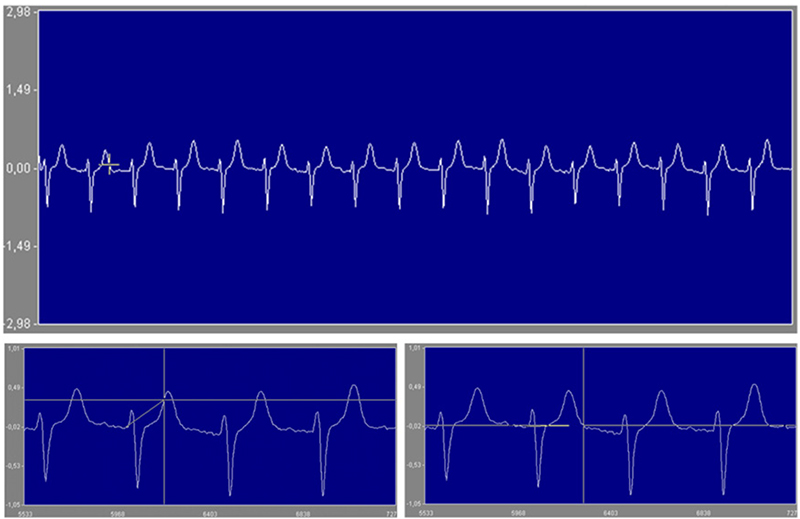Volume 33, Nº 3, May and June 2020
DOI: https://doi.org/10.36660/ijcs.201810681
ORIGINAL ARTICLE
QT Interval Dispersion Behavior in Patients with and without Obstructive Coronary Artery Disease Undergoing Exercise Test
Alexandre Maulaz Barcelos
Marcelo Perim Baldo
Sérgio Lamego Rodrigues
José Geraldo Mill

Figure 1 - Measurement sequencing of a QT interval.
Abstract
Background: Stress test is used to detect coronary artery disease (CAD). The QTc interval dispersion (dQTc) is an electrocardiographic index of ventricular repolarization heterogeneity. Some researchers have linked transiente myocardial ischemia induced by physical exertion with increased heterogeneity of ventricular repolarization measured by dQTc.
Objectives: To study the patterns of dQT in patients with and without chronic obstructive CAD and to define a reliable cutoff point for dQT that could become a diagnostic criterion for myocardial ischemia.
Methods: We retrospectively analyzed the electrocardiogram in resting and in exercise of 63 patients submitted to exercise test and cardiac catheterization. We divided the patients into three groups: true negative (VN), true positive (VP) and false positive (FP). VN: patients with coronary lesion lower than 70% and exercise test without myocardial ischemia; VP: individuals with stenosis greater than 70% in coronary arteries and a test suggestive of myocardial ischemia; FP: people with stenosis lower than 70% in the coronary arteries and stress test with ischemia criteria. Values of p < 0.05 were considered statistically significant.
Results: Resting dQTc was not different among the three groups. However, for the dispersion of the QTc interval in exercise was, respectively, 47 ± 17 ms, 72 ± 42 ms, and 61 ± 31 ms for VN, VP and FP (p = 0.003).
Conclusions: Obstructive chronic coronary disease patients have an increase in dQTc during exercise. Measurement of dQTc may be helpful in the diagnosis of myocardial ischemia in the stress test. (Int J Cardiovasc Sci. 2020; 33(3):263-271)
Keywords: Coronary Artery Disease/physiopathology; Exercise Test/method; Electrocardiography/method; Myocardial Ischemia; Electrophysiology; QT Dispersion Interval.











